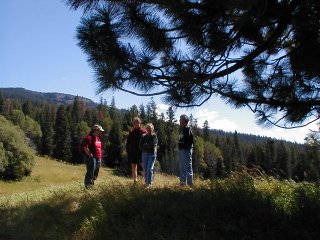Tsunami Earthquake of 1700 and the Meadow Landslide

Here we are at the meadow, standing on a hill that is part of the hummocky surface of a landslide. The hill most likely started out as a more angular block, but over time erosion has rounded it into a hill.
Chas says that there is a huge ponderosa pine on the landslide meadow that must be at least 300 years old. That rules out the 1872 quake as causing the landslide, but makes me wonder about the tsunami earthquake of 1700. Geologists made the news when they discovered that trees on the coast of Washington had been destroyed by a tsunami in the distant past, and they were able to correlate age-dating of the trees with a recorded tsunami event in Japan in 1700. That earthquake is estimated at a magnitude of 9+ on the Richter scale.
Since the Richter scale is logarithmic, an earthquake of 9 is 100 times more powerful than an earthquake of 7. The Wikipedia entry for the Richter Scale (see http://en.wikipedia.org/wiki/Richter_scale) says that a 9.0 earthquake would be "devastating in areas several thousand miles across." Enough power to cause the meadow landslide, even though it is more than 100 miles away from the Cascadia subduction zone fault where the earthquake was centered. Geologic phenomena can be sudden and huge as well as small and slow.

0 Comments:
Post a Comment
<< Home